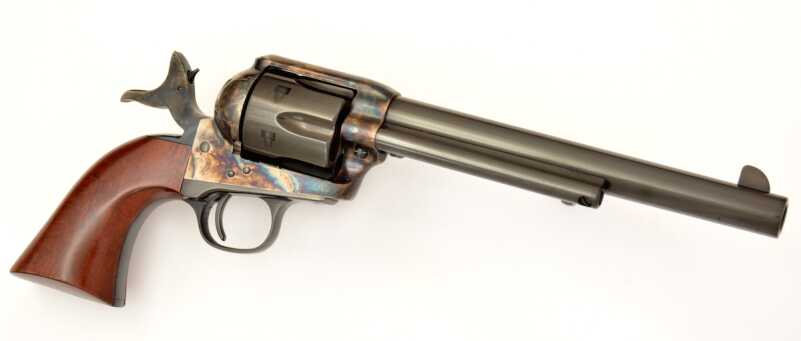
The Uberti Cattleman II is a revolutionary take on this classic design, featuring a retractable firing pin that allows the use of a full six rounds.
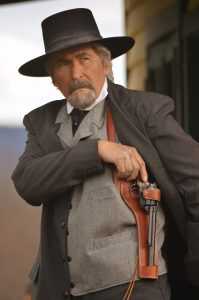
The new Uberti Cattleman II gives modern shooters a new take on a classic design. It is pictured in an El Paso Saddlery Tombstone Speed Rig shoulder holster based on the .c 1895 Al. Furstnow design. (Hat courtesy Golden Gate Western Wear)
In the latter days of the American West, shortly after the turn of the 20th century the Colt Model 1911 was fast becoming an option for lawmen and gunmen, as well as the U.S. military, which had adopted Colt’s new semiautomatic pistol as its standard-issue sidearm. There was, however, one early cautionary caveat; the 1911s were to be carried with an empty chamber in a flap holster, making them both slow to draw and slower still to get into action. This gave the “old reliable,” Colt’s legendary Peacemaker, an extended lease on life, even though military protocols also required carrying the Colt Single Actions with the hammer rested on an empty chamber.
There was a sense of elegance and simplicity to the Peacemaker’s original design. The mechanics were confined to only nine parts: mainspring, hammer swivel, hammer, short sear, short sear spring, long sear, lifter with spring (operates the lifter and long sear), trigger, and trigger spring. The remaining components of the SAA were cylinder pin and retaining screw, triggerguard and backstrap, hammer roller and hammer screw, hammer cam, hand (pawl), bolt, trigger, firing pin, and ejector assembly. The exterior bore three screws in the frame (one of which was the hammer screw), the retaining screw for the cylinder arbor, and the backstrap (2) and grip strap (1) screws. When one piece grips were replaced by two-piece grips, a grip screw was added to the parts list.
Between 1873 and the early 1900s the Colt’s Patent Fire-Arms Manufacturing Company had made literally dozens of improvements to the Peacemaker, including the most noteworthy change from the original Wm. Mason-designed “black powder” frame to the improved “smokeless powder” frame in 1892, which was symbolized by the new transverse cylinder latch replacing the original frame screw used to secure the cylinder pin. However, Colt’s did not formally pronounce the new models “safe for use with new smokeless powder cartridges” until 1900.
[one_third]
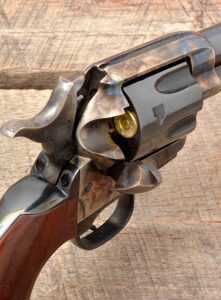
The Uberti Cattleman II with retractable firing pin has an authentic look when viewed from behind the hammer (shown at half cock).
[/one_third]
[two_third_last]
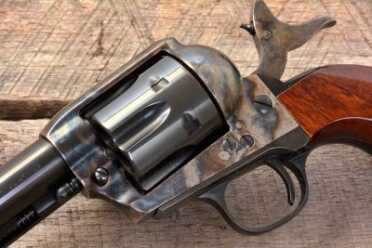
The Uberti Cattleman II, as with all Uberti SAA models, has the Colt’s Patent dates stamped on the lower left of the color casehardened frame. Also note the later transverse cylinder latch used on Colt SAA models produced after 1897.
[/two_third_last]
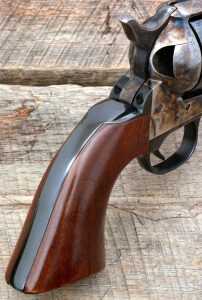
The Cattleman II is offered with color casehardened frame and brass triggerguard and backstrap or with blued steel triggerguard and backstrap as shown.
Prior to 1900 Colt stated that their revolvers were not designed for smokeless powder and in October 1898 this was a noted owner’s precaution. Beginning in 1900, Colt’s announced that their revolvers (serial number range beginning at approximately 192000) were guaranteed against smokeless powder. This had become necessary by the turn of the century, as the more powerful and cleaner-burning smokeless powder cartridges pretty much dominated the market.
Nearly all of the improvements Colt’s had made to the 1873 Single Action Army had been minor design alterations to cylinder flutes, front sights, ejector assemblies, hammers, grips, and choice of calibers. Nothing had ever been done to make the gun any safer to carry with the hammer resting on a loaded chamber. It was the nature of the beast, and a wise cowboy carried his Colt with only five chambers loaded unless he was getting ready for a fight or reloading in the middle of one. This is no doubt the origin of the cinematic cliché of the gunman opening the loading gate and checking his cylinder before a fight. In reality, it was a good time to add that sixth cartridge!
SPECS
Calibers: .45 Colt (tested), .44-40 WCF and .38/.357 Magnum
Barrel: 4¾ , 5½ and 7½ inches
OA Length: 10-13 inches
Weight: 35 ounces (average)
Grips: One-piece walnut
Sights: Fixed
Action: Single-action
Finish: Blued, case colored frame
Capacity: 6
MSRP: $549-$559
Making Changes
More than 140 years after the Colt SAA was invented, Uberti decided it was high time to change the rules and engineered a solution to the historic problem of having to “safely” carry a Single Action with the hammer resting on an empty chamber. And more to the point…since this has been done by other armsmakers for years using floating firing pins in the frame and transfer bars…to accomplish this feat without compromising the original Colt design by using a clumsy hammer safety or transfer bar to impinge on the otherwise classic lines of the original Colt hammer, firing pin or frame. For a proper Colt Single Action Army design you can’t have a hammer safety or transfer bar, thus for Colt the old empty chamber rule, like the gun itself, has pretty much survived for more than 140 years.
[one_half]

The Cattleman II’s internal safety mechanism disengages the firing pin when the gun is not cocked, thus allowing it to float free in the hammer. Cutaway images courtesy of Uberti.
[/one_half]
[one_half_last]

As the illustration shows, the firing pin can only extend and strike a chambered round when the hammer is cocked.
[/one_half_last]
The designers at A. Uberti (one of Italy’s oldest and most fabled makers of western handguns and rifles, which was founded by its namesake, Aldo Uberti, in the 1950s), have developed an internal hammer mechanism that works with a retractable firing pin floating free within an internal guide. When the hammer is not cocked the firing pin floats inside the head of the hammer and cannot exert any forward pressure on a chambered round. In order for that to happen, the hammer must first be cocked, and only then will the sear that engages the firing pin allow it to lock in the forward position. As soon as the gun is fired, or the hammer is lowered, the firing pin floats free again. Think of it as a Glock trigger safety inside of a revolver’s hammer. The best part is that from the outside the retractable firing pin allows the hammer and frame to look exactly as they should (and did back in the day), allowing this new line of Uberti Single Actions to look exactly like their historical predecessors.
On Target

Shoulder holsters were becoming very popular by the late 1880s. Just before the turn of the century, Miles City, Montana holster maker Al. Furstnow developed his famous “Sheriff’s Lightning Spring Shoulder Holster,” which became the first “skeletonized” shoulder holster design. (Holster by El Paso Saddlery)
Uberti offers its new Cattleman II with retractable firing pin chambered in .45 Colt, .44-40 WCF and .38/.357 Magnum with a choice of 7-1/2 inch, 5-1/2 inch or 4-3/4 inch barrel lengths. The guns feature a case colored frame and hammer, and choice of a brass triggerguard and backstrap for $549; or with case colored frame and blued steel triggerguard and backstrap for $559. Matched sets of Cattlemen II Steel, in .45 Colt or .38/.357 Magnum, are also available for $1,159.
The 7-1/2 inch model tested proved to be a well-balanced gun with standard-sized Single Action grips, and weighing in at 39.5 ounces (unloaded). The finish was highly polished for a good, deep blue gloss and the chemical case colors on the frame and hammer were rich in shades of blue and gray with hints of red.
One of the characteristics that often separate Colt Single Actions from Italian reproductions is the sound and feel of the hammer. A Colt hammer has a distinctive and audible four clicks as it is thumbed back. The Uberti, while comparatively smooth for a standard (un-tuned) action, has only three steps and a resistance of 7 pounds, 11.5 ounces, Colt actions average 7 pounds 2.5 ounces, so overall hammer draw on the Uberti is very close in feel if not sound. Trigger pull on the Uberti Cattleman II averaged a light and very crisp 3 pounds, 9.4 ounces.
[one_half]
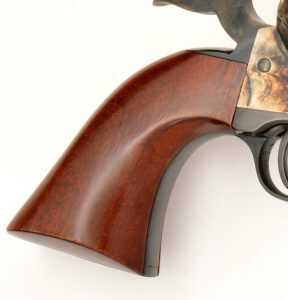
The Cattleman II comes with attractive Walnut grips. The author tested the version with the steel grip frame.
[/one_half]
[one_half_last]
[/one_half_last]
The result is an attractive and appealing revolver for Old West enthusiasts who want a classic-style gun that they can actually shoot. From its deep blued cylinder to its case colored frame to its attractive Walnut grips, this Uberti Cattleman II is a truly appealing gun. Add in the new firing pin safety mechanism that takes a retro classic design and brings it into the 21st century, and you have a gun that offers a lot to the modern-day shooter.
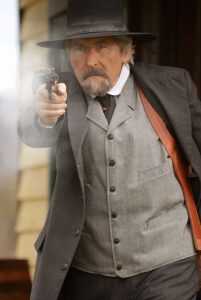
The Uberti Cattleman II has the heft, feel, and action of a smokeless powder frame Colt Single Action and proved to be just as fast to handle and just as accurate.
For the range test, shot at 15 yards (45 feet), aiming at a 20×16 inch cardboard target and firing one handed, gunfighter style, the ammo choices were divided between Ten-X .45 Colt 200 gr. RNFP, Goex Black Dawge 235 gr. RNFP black powder, and new Freedom Munitions’ Leadville 200-grain RNFP. Ten-X always has modest recoil and traveled down range at 621fps average. Black Dawge, the smokiest black powder cartridge around and guaranteed to provide a loud bark and commensurate kick, clocked a muzzle lifting 850 fps average, and the new Leadville, with the mildest recoil of all three .45 LC rounds, sauntered downrange at 601 fps average. With no appreciable recoil from the 7-1/2 inch Uberti SA, Leadville punched five rounds into the target at 1.5 inches with two overlapping pairs, Ten-X offered up its usual get-the-job-done accuracy with five clustering around a 2-inch circumference, and Goex slammed five into 2.18 inches with an overlapping pair. Shooting accuracy with Uberti Single Actions is always pretty good and the new Cattleman II was right up to snuff with these cowboy loads hitting the target just about point of aim from 45 feet. Bottom line, you can take this gun right out of the box and shoot a competition match. Might not be a fast as a tuned action (which one can always get done), but for $550 retail (and who pays retail?) this is one of the best Single Actions Uberti has ever built, and also one of the most authentic.

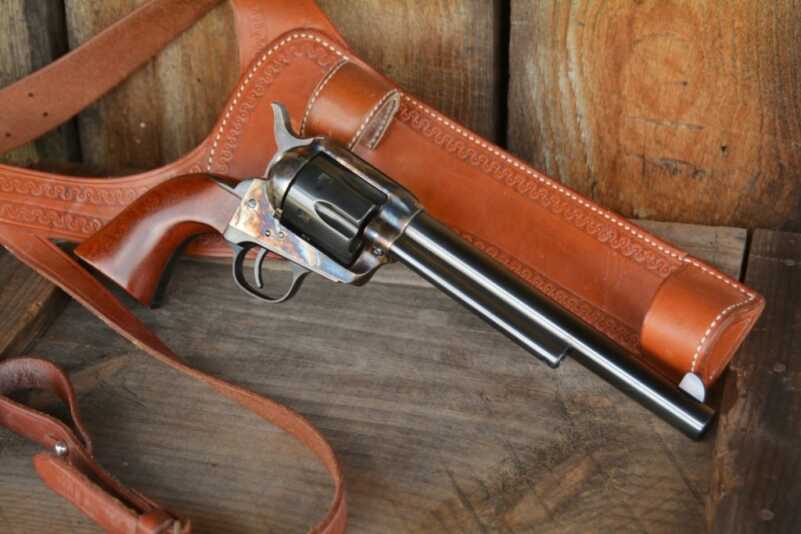
Uberti has been manufacturing superb Single Actions for decades and with the latest Cattleman II offers up a model that is not only accurate on the outside, but accurate in detail when you cock the hammer.
For more information visit https://www.uberti.com/.
To purchase a Uberti Cattleman II on GunsAmerica.com, click this link: https://www.gunsamerica.com/Search.aspx?T=cattleman%20II


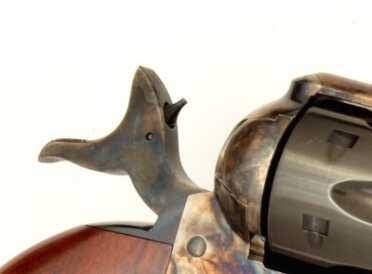
I have had an Uberti “Old West” on order for over a year, now. I have handled pistols most of my life, and I wanted a Colt replica SAA. I have a few Colts and I am very familiar with the company. Sam Colt WAS Colt, after his time Colt got by on selling the name; they do not mine special steel from Krypton, their machinists and assemblers are not wizards or aliens. Without their over-charging the US Gov’t, the mismanagement has them now owned by a Chechen company after being in bankruptcy too deep and too long. The magic is the legend. That said, no way is a new Colt 73 SAA worth $2K just because it’s made by Colt, the quality of which has been subject to a lot of dissatisfied customers, myself near the front of that line. I see too many here that do not realize that “the Italians” have been under license/contract to carry on those units that Colt no longer wanted to bother with manufacturing. Uberti and Pietta are both now owned by Pedersoli which in turn is owned by Benelli. Folks that make sporting shotguns worth thousands and are on sound financial footing probably do not suck. Italians like Beretta and Franchi round out the top-of-my-head list, so I submit that they make some of the finest firearms in the world. Beretta’s 92 even replaced my FAVORITE Colt 1911, I wasn’t happy about it. Even though I seem to be more accurate with the 92, I still prefer the 1911. Point? Let’s get off of the “Colt is God” kick and be thorough. In the testing Colt did, even their rep preferred the Uberti to the Colt. Back to my original point; it was brought to my attention that which is mentioned here more than once. Uberti, “II”, stuck with a non-original safety and a 3 click hammer, for what I’m paying? I’m thinking on striking the order and start haunting the gun shows; Uberti, you blew it.
My new Uberti ‘Devil Anse’ edition SAA 357 is probably the most bad-ass & beautiful all black SAA ever made…
and Taylor ( where I bought it ) also tuned & slicked it out for an extra $150. $800 total.
The hammer w/pin style is a must have unlike the Ruger..they have the more modern ‘gentleman’s hammer’ I call it.
Have a Cattleman II in brass blackstrap and trigger gaurd. Was imported to Taylor’s & Co. In 2015. Changed out the handle to American walnut checkered grips, tuned, changed springs and hammer.
Not only a work of firearm art but shoots accurate.
If you’re only dealing with one or two opponents and you know the drill and trained you can still fight effectively with it.
This innovation by Uberti is ok if you are just going to the range to practice, but I doubt if SASS will modify their rule that all 6 shooters be loaded with 5 rounds and the hammer down on an empty cylinder. I also agree with the comment that Uberti should have offered an option to the buyer as to having a gun with the old hammer system or this new “floating firing pin” model. Just sayin’…
I agree completely. after reading and more reading i felt confident with my new cattleman old model. after disassembly, i was baffled after seeing the internal disconnect in the hammer. it should not have been there. i love the gun, but still disappointed by what , to me, is a deception.
Where can i find a replacement hammer for my Uberti pistol?? Part number PU 1875 I’m told this part is no longer in production ???? SASS Cowboy shooter # 793
Uberti uses a chemical process to color case harden their parts. Colt, Standard Manufacturing and Turnbull use bone charcoal to obtain the rich color you see on Colts and high end clones. It is time consuming and an age old practice. Uberti makes an excellent weapon FOR THE MONEY. You are paying a quarter of the cost for a standard Uberti than for a Colt or Standard Manufacturing.
About the floating firing pin, I wish they would let the customer make a choice in that they would offer in both options. However I do applaud the effort in doing their best to keep their SAA as authentic as possible AT AN AFFORDABLE PRICE.
Wow, please cut that horrible music out. Not only does it sound terrible, it is much louder than the video itself. We know guns are cool and badass, we don’t need crappy aggressive music to understand that. Good video otherwise.
I have a couple of the new Uberti’s (Just purchased this week) and I have several earlier models as well. Those who complain about “authenticity” need to see how many lawyers are in the USA ! The addition of the extending firing pin does two things in addition to making the pistol safer; it increases the locktime slightly and increases the trigger pull. I believe that over time, those two things will improve, I’ll see. They are much preferable to the transfer bar type, in terms of appearance, but I do miss the 4-click sound of the hammer. All of the “genuine” Colt’s that I have were assembled from Uberti parts—so there you go (although assembly, tuning, and final fitting were done here.)
Why in God’s name would Uberti take it on itself to make a change to a 150 year old design? Ruger had already done this and the transfer bar made the Cattleman a replica Ruger Single Six rather than a Colt replica. Why wouldn’t Uberti keep the original design and add the newer model and let the buyer choose which system they want? That makes more business sense to me as I will not EVER buy this new pistol even though my gun safe is full of Uberti firearms. Why do these manufacturers take away our freedom of choice when they could sell to both?
I’m laying here in a hospital bed . Wishing they’d have started from the beginning. If you want original. Take the extra cash and buy a real Colt . I’ve got so many with transfer bars ! Picked one up with out and lo and behold her I am with a shattered knee and bullet and bullet fragments permanently embedded in my thigh . Wish to hell it would have had a floating hammer. Believe me when I tell you if you have a remake nobody gives two craps worth if it’s truely authentic because if it meant that much to you you’d be using an Authentic Colt . I’m a very experienced weapons handler and can only imagine how many poor novices that end up with these non safe knockoffs are getting shot or shooting people accidentally or just close calls . Hats off to them for trying to make our shooting world a safer place to enjoy . Hope I’m able to walk normal someday to get a replacement hammer/floating firing pin and be able to enjoy shooting again ! Sincerely RB from Ohio
So who is right about the case coloring ?
I noticed in the review that there was no mention to the grips as being the same size and configuration as Colts or the original Cattleman. Anyone know about this? Please leave info.
As far as I know, the grips on the new Cattleman II are the same as on the previous Cattleman version. And, as far as I know, the grips are based on the original one-piece grips of the Colt SAA. It wasn’t long (not sure how long) before Colt switched to a 2-piece grip. My guess is that the 2-piece grips used less material and were cheaper to produce than a solid, single piece grip.
The Colt two-piece grips were made of black hard rubber. And yes, they were much cheaper to produce since they are molded not carved. However, afaik, Colt maintained the ability to make custom carved grips through its Custom Shop, which included real ivory. The Italian manufacturers have four basic grips: the original 1851/1861/1873 grips, the longer 1860 Army grips, the Bisely grips and the bird’s head grips (the latter two of which require different grip frames). It always kind of surprised me that the Colt 1873 did not have Army grips. The 1860 Army was a more powerful handgun than the .36 caliber 1851, so it was given more grip real estate. But while the 1861 could easily be loaded to 35 grains of black powder (although Army standard load was only 30), which was more than double the load for the 1851, the .45 Colt cartridge was designed for 40 grains and was usually loaded to 35 for Army munitions..
When I decided to purchase a SAA clone, I chose the Uberti Cattleman because of the level of authenticity it seemed to have. As I searched around for the specific model I wanted (.45 cal, Case Hardened frame, 7.5″ barrel), I found none available, new or used. I spoke with Uberti’s USA reps and was told the Cattleman II would be the only version offered from this time on. I pre-ordered one from the next production run and I just got it today. It’s a beautiful gun, but I was more than a bit disappointed when I pulled the hammer back and heard only 3 clicks. What a let down! For a company like Uberti that prides itself on the authenticity of its reproductions, how hard would it have been to engineer in a “quarter cock” just for old times’ sake? It may look like a SAA, but it definitely doesn’t feel like one. The previous version had the signature “C-O-L-T” feel and sound. With the Cattleman II, all I get is “C-O-L”. I’m a bit T’d off. Still, as I said, it is a great LOOKING gun. I can’t wait to take it to the range tomorrow.
Neither the Uberti nor the Pietta have three clicks in any of their reproductions, including the black powder pistols. They may have simply decided that this first quarter click has no utility, since the gun can only be reloaded on half click, at which point the sear is in a slot and simply cannot fall if the trigger is accidentally pulled and the locking cam is released. I must admit however that I have never handled an original colt.
It is a timing issue. Not a new Safety thing. Whomever timed it at the factory timed the cylinder bolt to pop up at the same time as the full cock notch.
There ARE 4 clicks! Listen carefully at click 3 or you’ll go past number 4. Go slow! You might have to do it a couple of times till you hear the fourth click.
I am glad Uberti has joined the club on a internal saftey. Pietta is using a transfer bar on their newer Traditions line. Ruger, EAA and Herritage have been doing it for years. An empty chamber is 17% less capacity on a 6 shot revolver, and that’s significant. Not being able to carry six on the original SAA was a design defect. Yet, some modern cowboy shooters still embrace it in the name of authenticity. As for me, I’ll safely take all six in my six-shooter, thank you.
Frankly, I’ve had a Uberti “4-click” model for decades. The first “click” is what we usually refer to as a quarter-click, which allows you to carry a full 6-shot load without fear of unintentional discharge, because the hammer is locked back just enough so that the firing pin does not protrude into the cylinder area. It does NOT “rest on the cartridge primer” as some have stated, PROVIDED that you remember to use the quarter-cock feature, which I have done on countless trips to the range. Obviously, since I am not a 19th Century gunslinger, I have no need to carry the gun for self-defense anyway. I have other, more modern guns for that. Regardless, like any firearm, the original design is as safe as its owner, and I prefer to keep “clones” of classic designs exactly as they were intended. I agree with one commenter who said Uberti should offer both, and let the customer decide.
Wow. That ‘music’ at the beginning of GA videos is really impressive. I’m sure glad GA didn’t choose anything too obnoxious. ‘Might give folks the wrong impression of those of us who value life without drug abuse.
Great review. I once had a .22 Peacemaker. Couldn’t hit the broad side of a bull’s ass with it. Wasn’t his fault though. Nice gun.
A good review of a well made and innovative take on an old revolver design.
I do take exception to the marketing of this article. There is NOTHING about this Uberti firing pin safety that is in ANY way related to any part of a Glock pistol. To try to use the Glock name to imply they invented a safer trigger is misleading. Even the Glock safe action trigger was copied from the 1930s Mauser HSC.
Apparently the writer, for all of his western repro dude, has either:
Not the faintest idea how either a Glock or a SAA works,
Or
Worse, is so ill informed about his readers that he throws the word Glock in to try to get readers to read an otherwise well written article on the new hammer and firing pin.
Kudos to Uberti for making a traditional looking SAA that appears safer than a traditional fixed firing pin. I still recommend loading five.
He was not talking about the so-called “safe action trigger,” but the fact that the firing pin floats and does not contact a primer unless the gun is fired. The Colt originals do contact primers if the hammer is down on a loaded chamber, and the guns are thus not drop safe. The Ruger and Pietta transfer bar safeties are one way to lick this issue, but at the expense of the fining pin sticking out of the hammer, leaving a flat face instead.
Why is the velocity so low now days in .45 Colt? If I remember correctly the old Winchester factory were around 850fps or so
I once had around 20 old UMC semi-b head cases and could get 40 gs. of 3f along with a 250gr Remington hollow base bullet in them Out of a 71/2 Ruger they got over 1,000 fps. with 2f around 850 fps Usually used 8 to 9 unique. for 900 -1000fps.
You are correct about the loads being light. Originally the .45 Colt was loaded with 40 grains of black powder (3f I believe, but not sure), but reduced that to 35 grains at the Army’s request. With a full load, speeds were typically in excess of 1000 fps.
Today, many commercial rounds are loaded light for cowboy action shooting, where speed and accuracy are preeminent, often no faster than 750 fps. As one would expect, it is harder to make accurate fast shots with more powerful loads. I have seen hot loaded rounds, but what I’ve seen runs well north of $1 per round (even $1.60!). One would do better reloading with 3F powder and cast lead bullets, light rounds (185 or 200 gr) for targets/cowboy shooting, Keith’s 250 or 300 gr for hunting.
Now, I would not want my comment to be misinterpreted or perceived as a criticism or negative description of Uberti products. I only report the facts I experienced. Back in the 60s, I bought in Italy a brand new Uberti Single action revolver in 357 Magnum. After approximately 20 rounds, the cylinder got out of adjustment, moved slightly sideways and it would take two hands and some real force to cock the hammer and turn he cylinder. After deliberation the “gun” ended in the water in the port of Naples.
I only mention this as my personal experience with ONE of Uberti’s products and do not intend to mean that ALL Uberti hardware has fatal flaws. Many seem delighted with these and I may very well have the unlucky one who happened to get the only one ever Uberti gun that was totally defective. Also that was 50 years ago. Who knows. perhaps their production today is totally perfect. One thing, I shall NEVER acquire at any price one of those foreign made Old West style imitation implements. I got myself a genuine Colt SAA, 3rd Generation in a 5’8″ barrel and also a genuine Colt Buntline 3rd Generation in 45 LC. No problem ever. I would also seriously have considered Ruger but after all if you want a Colt “Peacemaker” there is only one COLT. The rest is only ersatz.
Most likely Uberti made your “Colt” parts. One gun from the 60s influenced your purchasing? It’s enough to even comment as well? I don’t see it.
Would you buy a second Yugo ?
A 5 foot 8 inch barrel? I ain’t never seed one o’ dem. Plus the Third Gen Colts (black powder) were not actually Colts, but Italian parts (most likely Uberti) assembled in the US, with finishes to Colt spec by Colt Blackpowder Arms Co. of NY:
COLT BLACKPOWDER ARMS CO. Previous manufacturer and retailer of 3rd Generation Colt Black Powder pistols and muskets located in Brooklyn, NY 1994-2002.
All 3rd Generation Colt blackpowder models are also referred to as Signature Series Models.
A reprise of the original Colt Blackpowder line, along with historic models not offered in the 2nd Generation, and a new series of Commemoratives, each model (with the exception of the Heirloom Tiffany 1860 Army and 1842 Texas Paterson) bears the Sam Colt signature on the backstrap. These 3rd Generation models were manufactured under an authorized licensing agreement with Colt Firearms by Colt Blackpowder Arms Company – the same company (and many of the same craftsmen) responsible for the 2nd Generation Colt revolvers. Although parts for the Signature Series were cast in Italy, they were fully assembled and hand finished in the United States using the proprietary Colt formulas for bluing and color case hardening.
Colt Blackpowder Arms Company Signature Series revolvers are regarded as authentic Colt pistols. The 3rd Generation models have original Colt markings, including the barrel address and serial number stampings. There are no foreign proof marks on these authentic Colt models.
Dear Mr. Mark M.
My sincere and deep apology for the errors contained in my comments. I would only wish to remind myself that the old saying goes ” a shot of Jack Daniels with a mug of Pilsen do not mix well with keyboards”. I shall therefore humbly make the necessary correction.
1- I do not recall making any reference to Colt 3rd Generation BLACK POWDER. Though imbibing the aforementioned noble spirit may have altered my recollections as well as magically removed said BLACK POWDER alleged statement.
2- I am most grateful for your correction and astonishment at the mention in my comment about the existence of a mythological, magic and homeric Colt with a five foot eight inch (5’8″) barrel. I must extend my sincere and humble compliment for your highly praised expertise and vigilant eye for detecting such an enormous misstatement on my part. I indeed must now give all the noble experts here present the true size of this Colt I am honored to possess: FOUR INCHES AND THREE QUARTER (4″ 3/4), according to Colt data. I unfortunately do not spend any my precious hours and minutes measuring gun barrels, being occupied with reloading and shooting. Any possible error in the barrel length may addressed to Colt directly,
I am forever in your debt for gracing us and I in particular for your esteemed knowledge and your learned weaponry expertise as well as the mention of Colt BLACK POWDER.
Thank you
I own a Cattleman in .45LC and looking at the photos I couldn’t tell if my pistol had the firing pin safety.
Is there a way to tell or find out weather or not that system is applied to my gun? Also can it be done aftermarket like Ruger did with the transfer bar safety system?
It is too new to have an aftermarket. Yours is just a fixed firing pin gun.
“Load one, skip one, load four.” A simple refrain for a simple single-action. Why complicate the mechanics of a revolver that has proven itself reliable for nearly 150 years? Uberti makes fine reproductions of Colt’s famed single-action, but for someone seeking nostalgia and originality of function, the company may have solved a problem that does not exist. If they have, they are a little late to the table. Bill Ruger’s single-action has been loading six for decades. Authentic reproductions should be authentic in every detail, idiosyncrasies and all. Or to put it another way, “Don’t fix it if it ain’t broke.”
Try and be a high-volume gunmaker and sell to the very litigious American market. After the 10th time you get sued by some idiot who shot himself in the nuts because he loaded all 6 in a 6-shooter, an internal safety system becomes a necessity. This ain’t the 1880’s, Toto.
Ingenious. I have two Piettas with the transfer bar safety, and yes, they look just a little bit odd. Interestingly enough, Pietta recommends only loading five, even with the bar. And the bar does effect the trigger; there is a slight extra “catch” when the trigger is released after firing. It is not too hard to tune out the scraping sound it makes when it rides up and down, but I really like Uberti’s idea here. I just wish they could get their case hardening up to the rich colors that Colt makes these days.
I concur. Great design.
The color case hardening on Uberti isn’t the real deal like it is on Colts.
In what way genius? There is really only one way to case harden steel and I can assure you that Uberti does a gorgeous and high quality job in old world facilities in Italy. Uberti has made most of the SAA and BP Colts for a generation.
Well stated… Uberti’s color case harden is just as gorgeous, if not prettier than some of Colt’s work.
You can case harden via actually hardening the metal in the presence of carbon, or you can pour chemicals on the steel which impart colors that look like color case hardening. The latter is how the Italian makers do it.
That is so not true. They are charcoal case hardening just like everyone else. You can’t get blues and purples with a chemical.
I have both Uberti and Pietta pistols, plus I have looked at a large number on display. Most of the Ubertis I see are more gray than anything else, with a puddle of blue here or there on the frames. Piettas are usually better. For rich color, compare either of these to a Colt or Turnbull; the Italians do not compare (except in their advertising). Why one has better color than others is a mystery to me.